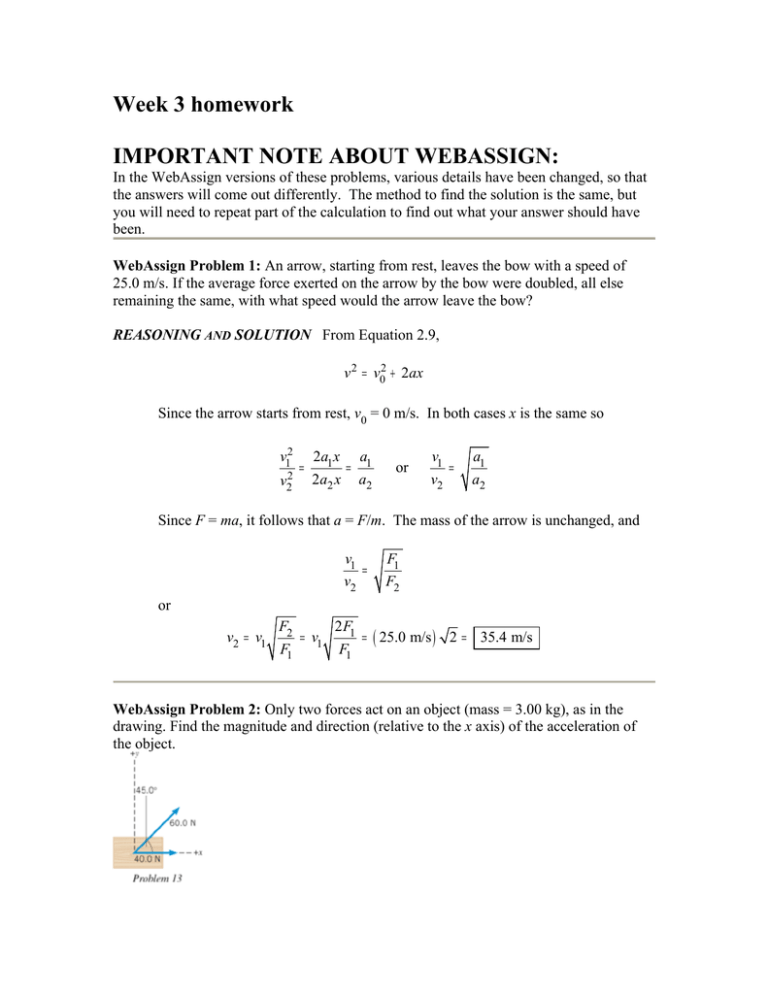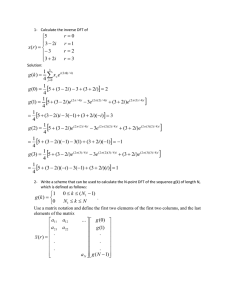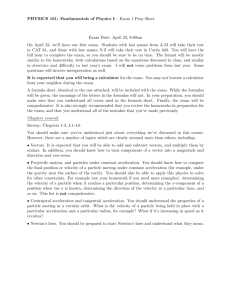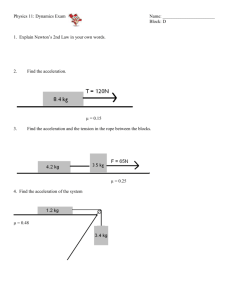Week 3 homework
advertisement

Week 3 homework IMPORTANT NOTE ABOUT WEBASSIGN: In the WebAssign versions of these problems, various details have been changed, so that the answers will come out differently. The method to find the solution is the same, but you will need to repeat part of the calculation to find out what your answer should have been. WebAssign Problem 1: An arrow, starting from rest, leaves the bow with a speed of 25.0 m/s. If the average force exerted on the arrow by the bow were doubled, all else remaining the same, with what speed would the arrow leave the bow? REASONING AND SOLUTION From Equation 2.9, v 2 = v02 + 2ax Since the arrow starts from rest, v0 = 0 m/s. In both cases x is the same so v12 v22 = 2a1 x a1 = 2 a2 x a2 or v1 = v2 a1 a2 Since F = ma, it follows that a = F/m. The mass of the arrow is unchanged, and v1 = v2 F1 F2 or v2 = v1 F2 2 F1 = v1 = ( 25.0 m/s ) 2 = 35.4 m/s F1 F1 WebAssign Problem 2: Only two forces act on an object (mass = 3.00 kg), as in the drawing. Find the magnitude and direction (relative to the x axis) of the acceleration of the object. REASONING According to Newton's second law ( ∑ F = ma ), the acceleration of the object is given by a = ∑ F / m , where ∑ F is the net force that acts on the object. We must first find the net force that acts on the object, and then determine the acceleration using Newton's second law. SOLUTION The following table gives the x and y components of the two forces that act on the object. The third row of that table gives the components of the net force. Force x-Component y-Component F1 40.0 N 0N F2 (60.0 N) cos 45.0° = 42.4 N (60.0 N) sin 45.0° = 42.4 N ∑ F = F1 + F2 82.4 N 42.4 N The magnitude of ∑ F is given by the Pythagorean theorem as ΣF = (82.4 N)2 + (42.4)2 = 92.7 N The angle θ that ∑ F makes with the +x axis is −1 42.4 N θ = tan = 27.2° 82.4 N ΣF θ 42.4 N 82.4 N According to Newton's second law, the magnitude of the acceleration of the object is a= ∑ F 92.7 N = = 30.9 m/s 2 m 3.00 kg Since Newton's second law is a vector equation, we know that the direction of the right hand side must be equal to the direction of the left hand side. In other words, the direction of the acceleration a is the same as the direction of the net force ∑ F . Therefore, the direction of the acceleration of the object is 27.2° above the +x axis . WebAssign Problem 3: The drawing shows three particles far away from any other objects and located on a straight line. The masses of these particles are , , and . Find the magnitude and direction of the net gravitational force acting on (a) particle A, (b) particle B, and (c) particle C. REASONING Each particle experiences two gravitational forces, one due to each of the remaining particles. To get the net gravitational force, we must add the two contributions, taking into account the directions. The magnitude of the gravitational force that any one particle exerts on another is given by Newton’s law of gravitation as F = Gm1m2 / r 2 . Thus, for particle A, we need to apply this law to its interaction with particle B and with particle C. For particle B, we need to apply the law to its interaction with particle A and with particle C. Lastly, for particle C, we must apply the law to its interaction with particle A and with particle B. In considering the directions, we remember that the gravitational force between two particles is always a force of attraction. SOLUTION We begin by calculating the magnitude of the gravitational force for each pair of particles: FAB = FBC = FAC = GmA mB 6.67 × 10 –11 N ⋅ m 2 / kg 2 ) ( 363 kg ) ( 517 kg ) ( = = 5.007 × 10 –5 N GmB mC 6.67 × 10 –11 N ⋅ m 2 / kg 2 ) ( 517 kg ) ( 154 kg ) ( = = 8.497 × 10 –5 N r2 r2 Gm AmC r2 ( 0.500 m ) 2 ( 0.500 m ) 2 6.67 × 10 –11 N ⋅ m 2 / kg 2 ) ( 363 kg ) ( 154 kg ) ( = = 6.629 × 10 –6 N ( 0.500 m ) 2 In using these magnitudes we take the direction to the right as positive. a. Both particles B and C attract particle A to the right, the net force being FA = FAB + FAC = 5.007 × 10 –5 N + 6.629 × 10 –6 N = 5.67 × 10 –5 N, right b. Particle C attracts particle B to the right, while particle A attracts particle B to the left, the net force being FB = FBC – FAB = 8.497 × 10 –5 N – 5.007 × 10 –5 N = 3.49 × 10 –5 N, right c. Both particles A and B attract particle C to the left, the net force being FC = FAC + FBC = 6.629 × 10 –6 N + 8.497 × 10 –5 N = 9.16 × 10 –5 N, left WebAssign Problem 4: A block whose weight is 45.0 N rests on a horizontal table. A horizontal force of 36.0 N is applied to the block. The coefficients of static and kinetic friction are 0.650 and 0.420, respectively. Will the block move under the influence of the force, and, if so, what will be the block’s acceleration? Explain your reasoning. REASONING AND SOLUTION The block will move only if the applied force is greater than the maximum static frictional force acting on the block. That is, if F > µ sFN = µ smg = (0.650)(45.0 N) = 29.2 N The applied force is given to be F = 36.0 N which is greater than the maximum static frictional force, so the block will move . The block's acceleration is found from Newton's second law. a= Σ F F – f k F – µ k mg = = = 3.72 m/s 2 m m m WebAssign Problem 5: Part a of the drawing shows a bucket of water suspended from the pulley of a well; the tension in the rope is 92.0 N. Part b shows the same bucket of water being pulled up from the well at a constant velocity. What is the tension in the rope in part b? REASONING At first glance there seems to be very little information given. However, it is enough. In part a of the drawing the bucket is hanging stationary and, therefore, is in equilibrium. The forces acting on it are its weight and the two tension forces from the rope. There are two tension forces from the rope, because the rope is attached to the bucket handle at two places. These three forces must balance, which will allow us to determine the weight of the bucket. In part b of the drawing, the bucket is again in equilibrium, since it is traveling at a constant velocity and, therefore, has no acceleration. The forces acting on the bucket now are its weight and a single tension force from the rope, and they again must balance. In part b, there is only a single tension force, because the rope is attached to the bucket handle only at one place. This will allow us to determine the tension in part b, since the weight is known. SOLUTION Let W be the weight of the bucket, and let T be the tension in the rope as the bucket is being pulled up at a constant velocity. The free-body diagrams for the bucket in parts a and b of the drawing are as follows: T 92.0 N 92.0 N W W Free-body diagram for part a Free-body diagram for part b Since the bucket in part a is in equilibrium, the net force acting on it is zero. Taking upward to be the positive direction, we have Σ F = 92.0 N + 92.0 N − W = 0 or W = 184 N Similarly, in part b we have ΣF = T−W = 0 or T = W = 184 N WebAssign Problem 6: In the drawing, the weight of the block on the table is 422 N and that of the hanging block is 185 N. Ignoring all frictional effects and assuming the pulley to be massless, find (a) the acceleration of the two blocks and (b) the tension in the cord. 67. REASONING AND SOLUTION Newton's second law applied to object 1 (422 N) gives T = m1a1 Object 1 Object 2 N1 Similarly, for object 2 (185 N) T T T – m2g = m2a2 W1 If the string is not to break or go slack, both objects must have accelerations of the same magnitude. Then a1 = a and a2 = –a. The above equations become T = m1a T – m2g = – m2a W 2 (1) (2) a. Substituting Equation (1) into Equation (2) and solving for a yields m2 g m1 + m2 The masses of objects 1 and 2 are a= m1 = W1 / g = ( 422 N ) / ( 9.80 m/s 2 ) = 43.1 kg m2 = W2 / g = ( 185 N ) / ( 9.80 m/s 2 ) = 18.9 kg The acceleration is m2 g ( 18.9 kg ) ( 9.80 m/s2 ) a= = = 2.99 m/s 2 m1 + m2 43.1 kg + 18.9 kg b. Using this value in Equation (1) gives T = m1a = ( 43.1 kg ) ( 2.99 m/s 2 ) = 129 N WebAssign Problem 7: In the drawing, the rope and the pulleys are massless, and there is no friction. Find (a) the tension in the rope and (b) the acceleration of the 10.0-kg block. (Hint: The larger mass moves twice as far as the smaller mass.) REASONING AND SOLUTION a. Newton's second law for block 1 (10.0 kg) is T = m1a (1) Block 2 (3.00 kg) has two ropes attached each carrying a tension T. Also, block 2 only travels half the distance that block 1 travels in the same amount of time so its acceleration is only half of block 1's acceleration. Newton's second law for block 2 is then 2T − m2 g = − 1m a 2 2 (2) Solving Equation (1) for a, substituting into Equation (2), and rearranging gives T= 1+ 1m g 2 2 1 m /m 2 1 4 ( ) = 13.7 N b. Using this result in Equation (1) yields a= T 13.7 N = = 1.37 m/s 2 m1 10.0 kg WebAssign Problem 8: As part a of the drawing shows, two blocks are connected by a rope that passes over a set of pulleys. One block has a weight of 412 N, and the other has a weight of 908 N. The rope and the pulleys are massless and there is no friction. (a) What is the acceleration of the lighter block? (b) Suppose that the heavier block is removed, and a downward force of 908 N is provided by someone pulling on the rope, as part b of the drawing shows. Find the acceleration of the remaining block. (c) Explain why the answers in (a) and (b) are different. REASONING AND SOLUTION a. The rope exerts a tension, T, acting upward on each block. Applying Newton's second law to the lighter block (block 1) gives T – m1g = m1a Similarly, for the heavier block (block 2) T – m2g = – m2a Subtracting the second equation from the first and rearranging yields m – m1 2 a = 2 g = 3.68 m/s m2 + m1 b. The tension in the rope is now 908 N since the tension is the reaction to the applied force exerted by the hand. Newton's second law applied to the block is T – m1g = m1a Solving for a gives ( 908 N ) – 9.80 m/s2 = 11.8 m/s2 T a= –g= m1 42.0 kg c. In the first case, the inertia of BOTH blocks affects the acceleration whereas, in the second case, only the lighter block's inertia remains. Practice conceptual problems: 1. Why do you lunge forward when your car suddenly comes to a halt? Why are you pressed backward against the seat when your car rapidly accelerates? In your explanation, refer to the most appropriate one of Newton’s three laws of motion. REASONING AND SOLUTION When the car comes to a sudden halt, the upper part of the body continues forward (as predicted by Newton's first law) if the force exerted by the lower back muscles is not great enough to give the upper body the same deceleration as the car. The lower portion of the body is held in place by the force of friction exerted by the car seat and the floor. When the car rapidly accelerates, the upper part of the body tries to remain at a constant velocity (again as predicted by Newton's first law). If the force provided by the lower back muscles is not great enough to give the upper body the same acceleration as the car, the upper body appears to be pressed backward against the seat as the car moves forward. 15. A 10-kg suitcase is placed on a scale that is in an elevator. Is the elevator accelerating up or down when the scale reads (a) 75 N and (b) 120 N? Justify your answers. REASONING AND SOLUTION If the elevator were at rest, or moving with a constant velocity, the scale would read the true weight of mg = 98 N. When the elevator is accelerating, the scale reading will differ from 98 N and will display the apparent weight, FN, which is given by Equation 4.6: FN = mg + ma where a, the acceleration of the elevator, is positive when the elevator accelerates upward and negative when the elevator accelerates downward. a. When the apparent weight is FN = 75 N, the apparent weight is less than the true weight (mg = 98 N) so a must be negative. The elevator is accelerating downward. b. When the apparent weight is FN = 120 N, the apparent weight is greater than the true weight (mg = 98 N) so a must be positive. The elevator is accelerating upward. 18. A person has a choice of either pushing or pulling a sled at a constant velocity, as the drawing illustrates. Friction is present. If the angle q is the same in both cases, does it require less force to push or to pull? Account for your answer. REASONING AND SOLUTION Since the sled moves with constant velocity, the force of kinetic friction is present. The magnitude of this force is given by μkFN, where μk is the coefficient of kinetic friction and FN is the magnitude of the normal force that acts on the sled. Furthermore, the horizontal component of the applied force must be equal in magnitude to the force of kinetic friction, since there is no acceleration. When the person pulls on the sled, the vertical component of the pulling force tends to decrease the magnitude of the normal force relative to that when the sled is not being pulled or pushed. On the other hand, when the person pushes on the sled, the vertical component of the pushing force tends to increase the normal force relative to that when the sled is not being pulled or pushed. Therefore, when the sled is pulled, the magnitude of the force of kinetic friction, and therefore the magnitude of the applied force, is less than when the sled is pushed. 22. A stone is thrown from the top of a cliff. As the stone falls, is it in equilibrium? Explain, ignoring air resistance. REASONING AND SOLUTION An object is in equilibrium when its acceleration is zero. When a stone is thrown from the top of a cliff, its acceleration is the acceleration due to gravity; therefore, the stone is not in equilibrium.




